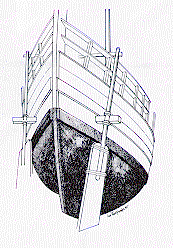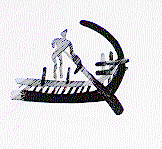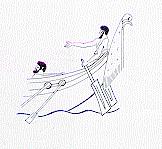OARS
 From antiquity to our own times, oars have been of two types: propelling and steering oars. Oars for propulsion do exactly what they are meant for - they push the ship forward or backward and even turn it left or right helping the steering oars or independently of them. They are placed perpendicularly in relation to the keel and horizontally in relation to the ship's deck, hooked at 2/3 of the length towards the rounded part which is held by the hands and they are immersed in the water moving in a circular way, so that the ship, with the thrust, may sail forward or backward.
Because of the perfection that characterized oars in antiquity, they have retained almost their "crude" form with few changes and improvements, at least in the propulsion oars. Steering oars have seen the greatest development and it is they that are now called rudders or simply steering wheels.
From antiquity to our own times, oars have been of two types: propelling and steering oars. Oars for propulsion do exactly what they are meant for - they push the ship forward or backward and even turn it left or right helping the steering oars or independently of them. They are placed perpendicularly in relation to the keel and horizontally in relation to the ship's deck, hooked at 2/3 of the length towards the rounded part which is held by the hands and they are immersed in the water moving in a circular way, so that the ship, with the thrust, may sail forward or backward.
Because of the perfection that characterized oars in antiquity, they have retained almost their "crude" form with few changes and improvements, at least in the propulsion oars. Steering oars have seen the greatest development and it is they that are now called rudders or simply steering wheels.
 The Kyrenia ship presumably used two steering oars at the stern and four propulsion oars, which were as many as the crew on board.
The Kyrenia ship presumably used two steering oars at the stern and four propulsion oars, which were as many as the crew on board.
 The steering oar or quarter-rudder, which is fixed in the rear of the ship and is either single or double, directs the ship on its course with the right inclination, depending on the course the ship will follow.
The steering oar or quarter-rudder, which is fixed in the rear of the ship and is either single or double, directs the ship on its course with the right inclination, depending on the course the ship will follow.
Go back to the previous page
Monday, May 27, 1996 11:59:56 PM
 From antiquity to our own times, oars have been of two types: propelling and steering oars. Oars for propulsion do exactly what they are meant for - they push the ship forward or backward and even turn it left or right helping the steering oars or independently of them. They are placed perpendicularly in relation to the keel and horizontally in relation to the ship's deck, hooked at 2/3 of the length towards the rounded part which is held by the hands and they are immersed in the water moving in a circular way, so that the ship, with the thrust, may sail forward or backward.
Because of the perfection that characterized oars in antiquity, they have retained almost their "crude" form with few changes and improvements, at least in the propulsion oars. Steering oars have seen the greatest development and it is they that are now called rudders or simply steering wheels.
From antiquity to our own times, oars have been of two types: propelling and steering oars. Oars for propulsion do exactly what they are meant for - they push the ship forward or backward and even turn it left or right helping the steering oars or independently of them. They are placed perpendicularly in relation to the keel and horizontally in relation to the ship's deck, hooked at 2/3 of the length towards the rounded part which is held by the hands and they are immersed in the water moving in a circular way, so that the ship, with the thrust, may sail forward or backward.
Because of the perfection that characterized oars in antiquity, they have retained almost their "crude" form with few changes and improvements, at least in the propulsion oars. Steering oars have seen the greatest development and it is they that are now called rudders or simply steering wheels. The Kyrenia ship presumably used two steering oars at the stern and four propulsion oars, which were as many as the crew on board.
The Kyrenia ship presumably used two steering oars at the stern and four propulsion oars, which were as many as the crew on board. The steering oar or quarter-rudder, which is fixed in the rear of the ship and is either single or double, directs the ship on its course with the right inclination, depending on the course the ship will follow.
The steering oar or quarter-rudder, which is fixed in the rear of the ship and is either single or double, directs the ship on its course with the right inclination, depending on the course the ship will follow.